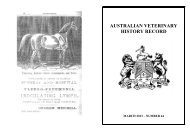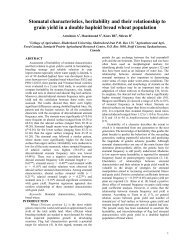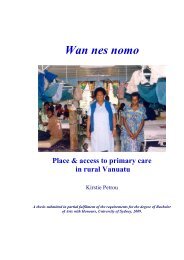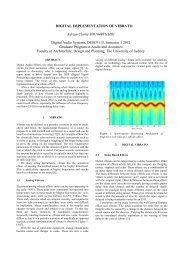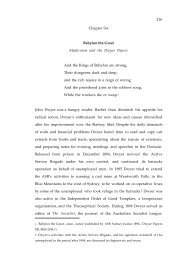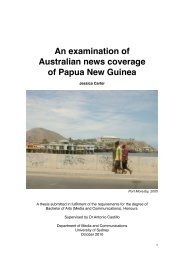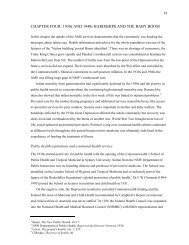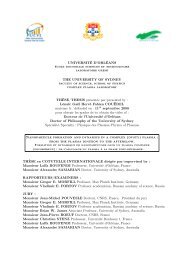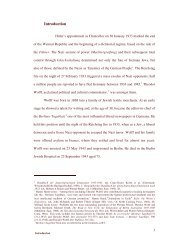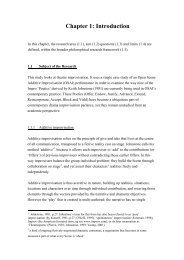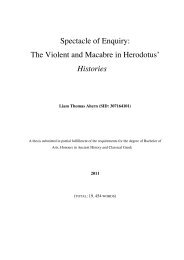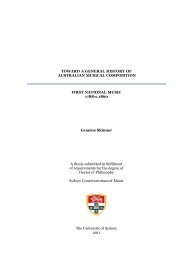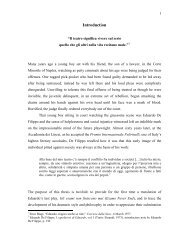Chapter 6: Tense, aspect and mood
Chapter 6: Tense, aspect and mood
Chapter 6: Tense, aspect and mood
Create successful ePaper yourself
Turn your PDF publications into a flip-book with our unique Google optimized e-Paper software.
(31) Nuw-angkarra. Nara ambaka-lhangwa kuw-angkarrv-na yeya-mvrra=wiya<br />
NEUT-run.P1 not later-ABL IRR.NEUT-run-P2 go.by.foot-?INSTR=PRG<br />
nuw-angkarrv-na. Nuw-angkarra, nuw-angkarra, nuw-angkarra. Ne-yaku-warrukwa<br />
NEUT-run-P2 NEUT-run.P1 NEUT-run.P1 NEUT-run.P1 NEUT/NEUT-river-cross.P2<br />
ebina adhalyvma m-ibina-lhangwiya mamarra. Bi...ya<br />
NEUT.that.same NEUT.river VEG-that.same-ABL.PRG VEG.small.leaved <strong>and</strong><br />
nuw-akuma-rna adhalyvma-manja a-ki-yak-bijina mamvdhangkwa-manja.<br />
NEUT/NEUT-put-P2 NEUT.river-LOC NEUT-CL:FLUID-river-beside VEG.s<strong>and</strong>-LOC<br />
Ngarnvngka na-lhawurradha, nuw-angkarra. Nuw-angkarru...wa. Engka<br />
again NEUT-return.P1 NEUT-run.P1 NEUT-run.P1…XTD NEUT.other<br />
na-rndarrka. Na-lhawurradha ebina-lhangwiya nga...wa, nuw-akuma-rna<br />
NEUT/NEUT-grab.P1 NEUT-return.P1 NEUT.that.same-ABL.PRG still…XTD NEUT/NEUT-put-P2<br />
ebina-manja angalya. Na-lhawu-lhawurradha, nuw-angkarra.<br />
NEUT.that.same-LOC NEUT.place NEUT-RDP-return.P1 NEUT-run.P1<br />
Nuw-angkidikarri-nu...wa. Na-ma-nga.<br />
NEUT-RDP.run-P2…XTD NEUT/NEUT-take-P2<br />
‘It [the cat (NEUT)] ran. It did not run slowly, it ran fast. It ran, <strong>and</strong> ran, <strong>and</strong> ran. It crossed<br />
over the river along the paperbark. Then it put the kitten down beside the river on the s<strong>and</strong>. It<br />
went back again, it ran off. It kept on running. It grabbed another. It came back along the<br />
same way, it put the kitten down in the same place. It kept going back, it ran off. It kept<br />
running. It took another.’ (‘Bujikeda’ y38-55)<br />
This prolonged event of the cat rescuing her kittens is broken up into pieces. Motion verbs marked<br />
P1 that signal atomic events express the stop-<strong>and</strong>-go motion of the cat. Interestingly, these markers<br />
of atomicity can co-occur with reduplicated verbs in Enindhilyakwa, something that Heath claims<br />
is not possible for Punctual <strong>aspect</strong> in Wubuy (1984: 341). Reduplication here signals repetition of<br />
an event that is portrayed as instantaneous <strong>and</strong> non-durative.<br />
6.6 Composite <strong>mood</strong> marking<br />
As is characteristic of the non-Pama-Nyungan languages (Verstraete 2005), <strong>mood</strong> in<br />
Enindhilyakwa is not marked in one specific slot in the verb template, but spread over two slots,<br />
represented by a combination of morphemes in a prefix <strong>and</strong> a suffix slot. Two series of pronominal<br />
prefixes encode the broad modal categories of realis <strong>and</strong> irrealis, which are combined with the<br />
suffixes to mark various modal <strong>and</strong> non-modal meanings. For example, the combination of an<br />
irrealis prefix with a P2 suffix in (32) signals counterfactuality, that is, the speaker’s assessment<br />
that something could have happened but did not.<br />
(32) dh-akvna kvnga-ma-ngv-mvrra kembirra arakba ki-yengbi-nv-ma ngayuwa<br />
3f-that IRR.1/3f-take-P2-ma then compl.act IRR.1-speak-P2-ma 1.PRO<br />
‘had I married her, then I could have spoken to her’ (‘Old days’ f13)<br />
The fact that both the prefix <strong>and</strong> the suffix element contribute to <strong>mood</strong> marking can be shown by<br />
comparing (32) with further examples such as (33) <strong>and</strong> (34), where variations of morphemes in the<br />
same prefix <strong>and</strong> suffix slots mark different types of <strong>mood</strong> categories. In (33), for instance, an<br />
220



